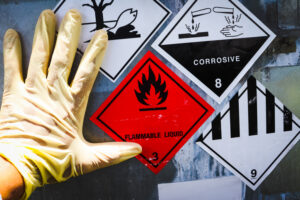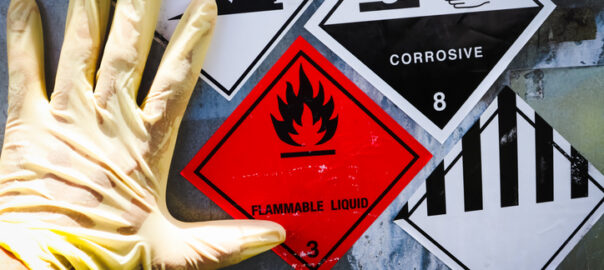Transporting hazardous material is risky if all companies involved are unaware of the hazardous material being carried. Truck drivers should be aware of all hazardous materials they are carrying. Failing to do so can result in unintentionally providing other carriers with non-compliant hazmat loads and equipment. Being compliant with hazmat standards takes a group effort, including the carriers, drivers, and shippers. All individuals must work together as a team to ensure that hazardous materials are being transported and delivered safely.

Must-Haves for Hazardous Material Transportation
Transporting hazardous materials can raise the risk of violations, fines, and penalties if you are not carrying the goods safely and adequately. When shipping hazardous products, shippers must:
- Have Hazmat Authority with the Safety and Security Expert, Environmental Health, or with another advisor.
- Protect carriers with professionally certified hazmat drivers.
- Guarantee that only professionally trained and qualified drivers access any portion of the hazardous transportation.
- Inform and comply with any changes in the hazmat regulations.
- Use caution when exposed to hazardous materials that are being shipped, along with its transportation and with the materials being shipped.
- Use an export if any business offers, stores, or uses hazardous chemicals to ensure safety in their process.
Am I Carrying Hazardous Material?
When truck drivers are carrying hazardous material, trucking companies need to ensure that everyone involved understands the type of material being carried along with safety measures to take. The Secretary of Transportation has defined hazardous material as “capable of posing an unreasonable risk to health, safety, and property when transported in commerce and has been designated as hazardous under the federal hazardous materials transportation law.”
Hazardous material can include:
- Substances
- Hazardous waste
- Marine pollutants
- Elevated temperature materials
- Liquid gasoline
- Ammunition
- Explosives
Classes of Hazardous Material
Hazardous materials are classified into different numbered classes. Before, hazardous materials were classified using alphabetical letters (A, B, C). With the change from letters to numbers, the classification also includes groups with alpha characters (1.1A, 1.2D.) These new classes include:
Class 1 – Explosives
- Division 1.1 Mass Explosive Hazard
- Division 1.2 Projection Hazard
- Division 1.3 Mass Fire Hazard
- Division 1.4 Minor Explosion Hazard
- Division 1.5 Very Insensitive Explosives
- Division 1.6 Extremely Insensitive Explosives
Class 2 – Gases
- Division 2.1 Flammable Gases
- Division 2.2 Non-Flammable Gases
- Division 2.3 Poisonous or Toxic
In Class 2, other materials that are compressed, dissolved under pressure, pressurized, liquefied, or liquefied gases can fall under this classification.
Class 3 – Flammable Liquid
- This class will include materials where the Flash Point (FP) is not above 141F.
Class 4 – Flammable Solids
- Division 4.1 Flammable Solid
- Division 4.2 Spontaneously Combustible Material
- Division 4.3 Dangerous When Wet
Class 5 – Oxidizing Substances; Organic Peroxides
- Division 5.1 Oxidizer
- Division 5.2 Organic Peroxide
Class 6 – Poisonous (Toxic) and Infectious Substances
- Division 6.1 Poisonous (Toxic) Material
- Division 6.2 Infectious Substances
Class 7 – Radioactive Material
Class 8 – Corrosives
Class 9 – Other Dangerous Materials
- Class 9 materials, such as lithium batteries and dry ice, do not require a hazmat vehicle for transport.
Failing to be Compliant
Each hazardous class poses a risk of contracting a penalty, fine, or violation. It does not matter whether the material falls under Class 3, which is helium, oxygen, or flammable liquids, or if it falls under Class 2.2 Non-Flammable Gas; each penalty, fine, and violation is equal.
Fines from Violation 107.329
- Civil Penalties: Maximum of $75,000.00**
- Criminal Penalties*: Individual – $250,000.00 and Corporation – $500,000.00
*$450.00 if the violations are related to training
** $175,000.00 if the violation caused severe injury, illness, or death to a person or had caused personal property damage.
Risks for Transporting Hazardous Materials
Everyone included in the transportation of dangerous goods poses a risk. This can consist of the shippers and manufacturers, carriers, owner-operators, and other drivers, as well as the public.
Shippers and Manufacturers
- A common risk of hauling dangerous goods is an injury to your person and property damage when not handling the material safely and adequately.
- Possible risk of penalties from the U.S. Department of Transportation (DOT) by the Pipeline and Hazardous Materials Safety Administration (PHMSA).
- State violations can incur towards the individual.
- Depending on the case, other government bureaus can become involved, including the Environmental Protection Agency (EPA) and the Occupational Safety and Health Administration (OSHA).
- Other hazards and risks can include – the general public could view you and your company in a negative way, the risk of losing the authority to transport hazmat goods, and even the risk of losing your business.
Carriers
Carriers can face the same risks as shippers and manufacturers, along with Compliance, Safety, and Accountability (CSA) points. These points are given to a carrier regarding violations during a DOT inspection.
Owner-Operators and Drivers
Just as shippers and carriers, owner-operators have the risk of the same penalties along with the risk of being suspended from being able to haul hazardous goods. When getting a penalty, drivers may also lose their truck lease or their job with their current trucking company.
Public
When transporting hazardous goods, the shippers, carriers, and drivers are not the only ones who pose a risk. The public could face risks, including accidents or incidents, when coming into close range of the hazardous material being loaded or unloaded.
Hazardous material transport regulations are important to understand, and all involved should be compliant with the shipment and only accept shipments that are compliant with these regulations. When accepting a hazmat load, shippers should inspect the hazardous material, carrier registration, and current hazmat permit. The carrier should also be financially stable, have the proper insurance and coverages for hazardous material transport, and must be professional and qualified. Shippers should only use well-known and trustworthy carriers who are trained in transporting hazardous goods to protect themselves and others legally.


